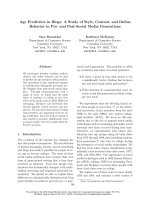Social media marketing in Vietnam A study of consumer profiles Marketing sử dụng truyền thông xã hội tại Việt Nam nghiên cứu hồ sơ người tiêu dùng
Bạn đang xem bản rút gọn của tài liệu. Xem và tải ngay bản đầy đủ của tài liệu tại đây (1.61 MB, 92 trang )
VIETNAM NATIONAL UNIVERSITY, HANOI
SCHOOL OF BUSINESS
TRAN THI THU TRANG
SOCIAL MEDIA MARKETING IN VIETNAM
A STUDY OF CONSUMER PROFILES
Major: Business Administration
Code: 60 34 05
MASTER OF BUSINESS ADMINISTRATION THESIS
Supervisor: Dr. Tran Doan Kim
Hanoi – Oct 2011
vii
TABLE OF CONTENT
Introduction 1
Motivations 1
Goals and Scope 2
Limitations 3
Chapter 1. Review of social media marketing 4
1.1. Concepts in social media marketing 4
1.1.1. Word-of-mouth 5
1.1.2. User-generated content and Web 2.0 6
1.1.3. Social technographic ladders 6
1.1.4. User-centered marketing communication 7
1.2. Social media types 8
1.2.1. Blogs 8
1.2.2. Chatting software and microblogging 9
1.2.3. Forums 10
1.2.4. Social news, social bookmarking and content aggregators 10
1.2.5. Social network sites 11
1.2.6. Media sharing and content communities 11
1.2.7. Integrated and mobile social media 13
1.3. More on social media marketing practices 14
1.4. Social media and social media marketing in Vietnam 16
viii
1.4.1. Social media landscape 16
1.4.2. Social media marketing 18
Chapter 2. Methodology for consumer research for social media users in Vietnam
20
2.1. Review of existing research 20
2.1.1. Thesis of (Ivanauskas, 2009) for the UK market 20
2.1.2. Thesis of (Khan, 2009) for markets of Italia, Spain, Pakistan and
Uzbekistan 22
2.2. Research strategy 23
2.2.1. Questionnaire design 23
2.2.2. Data collection process 24
Chapter 3. Consumer analysis and recommended entry strategy for marketing
management into social media 27
3.1. Consumer analysis 27
3.1.1. The consumer profile of web 2.0 citizen in Vietnam 27
3.1.2. User patterns in interaction with company 33
3.1.3. The profile of Vietnam social media users – an overview 38
3.1.4. The profile of Vietnam social media users – a deeper look 40
3.1.5. The influence of social media on Vietnamese consumers in marketing
communication 47
3.1.6. Findings 54
3.2. Recommended strategy for marketing management into social media 58
Conclusion and Future Work 61
References 63
ix
LIST OF FIGURES
Figure 3.1: Gender distribution of respondents. 27
Figure 3.2: Distribution of age groups 28
Figure 3.3: Income distribution amount respondents 29
Figure 3.4: Average rank of social media services in terms of popularity (the higher
rank – the more popular - means the smaller numerical value). 30
Figure 3.5: Distribution of places and locations. 31
Figure 3.6: Distribution in usage time per week. 32
Figure 3.7: Usage time among young people per week. 33
Figure 3.8: Preference of content types. 33
Figure 3.9: Reasons for users to start a conversation with company. 34
Figure 3.10: Reasons for users to stay engaged with the company. 35
Figure 3.11: Reasons for users to stay engaged with the company, among the age
groups. 35
Figure 3.12: Reasons for users to stay engaged with the company, among the
genders. 36
Figure 3.13: the personal reason to participate in conversation or interact with the
company through social media applications 37
Figure 3.14: The main obstacles to interact with the company through Social Media
Sites 37
Figure 3.15: Roles playing among respondents (a person may play multiple roles).
38
x
Figure 3.16: Roles playing by US users (Source: Forrester Research). 38
Figure 3.17: Role distribution of the two age groups 15-24 and 25-34. 39
Figure 3.18: Online behavior with respect to genders. 40
Figure 3.19: Preferences of content when Creators interact with the company. 41
Figure 3.20: What Creators will do after interacting with the company. 41
Figure 3.21: Social media that belong to the top two choices among Creators. 42
Figure 3.22: Time spent on social media sites by Creators and Critics. 43
Figure 3.23: Personal gains for using social media among Critics and Collectors 44
Figure 3.24: Preferences of content in interaction with the company by Joiners. 45
Figure 3.25: Main obstacles that stop Joiners from joining social media sites 46
Figure 3.26: Reasons for interacting with the company by Joiners and Spectators. 46
Figure 3.27: Preferences of content when Spectators interact with the company. 47
Figure 3.28: What users may do after interacting with the company through social
media services. 48
Figure 3.29: User responses to the question whether the company should contact
them for marketing purposes. 50
Figure 3.30: Media and their powers of influencing customer‟s mind. 53
xi
LIST OF TABLES
Table 1.3: Online community needs. Source: Ivanauskas (2009) 7
Table 1.1: How social media tools will meet business goals, Henna (2009) 14
Table 1.2: Opportunities and challenges of social media, Henna (2009) 16
Table 1.4: Why the Vietnamese go online? (Asia Digital Marketing Yearbook 2010,
citing from Cimigo Netcitizens) 17
Table 3.1: Correlation between social media types used and expected outcomes
after company-consume interaction (the numbers are the count of responses). 49
Table 3.2: Correlation between social media choice and responses to marketing
purposes. 51
Table 3.3: Preferences of commercial messages with respect to media choices and
origin of the messages. 52
Table 3.4: Technographics with respect to ads on different media. 54
Table 3.6: Summary of Vietnamese technographics. 57
1
Introduction
Motivations
With the advent of Internet in the last quarter of the 20
th
century and the public
availability of the World Wide Web in the early 1990s, the digital landscape has
completely changed. Access to a massive amount of information is just a click
away. Communication is made easy – we can now send emails to colleagues,
perform instant chats with friends, or even make long distant calls at the rate that
was not previously possible.
In the last few years, the change has been more profound – users are no longer a
passive consumer of existing Web content, they are actively creating new content
and sharing it. The change has resulted in a fairly firm body of knowledge known
as social media (sometimes, the citizen media). As the name suggested, this new
media is characterized by the social dimensions – the many-to-many interactivity
between users and the content being generated by the users rather than the
traditional publishers. According to Zarrella (2010), there are more than 346
million people who read blogs and more than 184 million people are bloggers
themselves. The move catches the attention of the general public by the constant
appearance of new buzzwords. For example, the word-of-the-year was “Blog” in
2004, “Podcast” in 2005, “Facebook” in 2007, and “Unfriend” in 2009 (New
Oxford American Dictionary).
This poses great challenges and opportunities for both businesses and academia
to study this fast changing cultural and social phenomenon. It is important to
understand the users of the new media. One of the most profound changes in
users is the shift from being the audience of the media to being the media
themselves. Thus the access to users is made easier, but the users have so much
power in generating the content, filtering out the messages, defining how the
messages will be passed. Social interaction is redefined substantially since there
2
are virtually no constraints on geography, physical presense in any conversation,
and on the number of audiences. The only limitations are perhaps the amount of
information processed by a typical user for a period of time, the difficulty of
cross-language communication, and the privacy concerns when going online.
The nature of new communication methods asks for a new look for the area of
marketing. In particular, we need to characterize the users as well as the ways
messages are generated, transmitted and received. For example, the nature of
word-of-mouth communication gives rise to two broad categories of users:
opinion leaders and opinion seekers (Gilly et al, 1980). A deeper look at the
nature of online usage, five types of users can be recognized: those who create
the content, those who make comment on content, those who simply join the
social network, those who collect and share the content and those who simply
consume content created by the others (Li & Bernoff, 2008).
Although social media in generally and social media marketing in particular are
in the current research agenda of many institutions, the number of studies is still
limited. The materials are in fact mostly made by marketing practitioners and
consultants, and those people who have positioned themselves as social media
experts (e.g. see Weinberg, 2009; Scott, 2010; Zarrella, D. 2010). These are more
about proposing marketing strategies for companies rather than understanding the
users, and there is little backup evidence on the proposed strategies. Furthremore,
very little research has been done for culture-specific social media marketing:
most research is reported on the US or European markets, and very little is on
other areas like Vietnamese users.
Goals and Scope
This thesis is aimed at deeper understanding of social media users in general, and
in the Vietnam market in particular. Despite lagging behind those leading
countries, Vietnam is catching up fast. The current Internet penetration rate is
estimated to be 35%, which accounts for roughly 30 million users – and is ranked
3
7
th
worldwide (Asia Digital Marketing Yearbook, 2010). Almost all young
generation users will be expected to go online in the next few years.
More specifically, we would like to answer three research questions. First, what
are the characteristics of Vietnamese users in the comparison with those of users
from other countries. Second, what are the impacts that the social media users
have on company‟s marketing goals? And third, what can companies do to utilize
the new media for their marketing/branding strategies?
We therefore aim to achieve three related goals:
Constructing a questionnaire that can help company to create social media
consumer profiles in Vietnam,
Determining whether social media can be considered as an effective
marketing channel, from the user perspectives, and
Deriving a list of recommendations for marketing management for entering
social media.
Limitations
In carrying out this study, we indentify that there are constraints that will limit
our results:
The time constraints for the Master thesis, as well as the resources allocated
to obtain answers in questionnaires from both users and companies.
The subject is new, and prior research materials are limited (although there
are currently a dozen of books and many websites devoted to the subject –
but these are generally non-research with little numerical evidences to back-
up claims).
4
Chapter 1. Review of social media marketing
In this chapter, we review the literature on social media marketing. In particular,
we will briefly describe social media concepts, their implications for marketing,
and finally the current state of social media and social media marketing in
Vietnam.
1.1. Concepts in social media marketing
Social media refers to those “relate to sharing of information, experiences and
perspectives throughout community-oriented websites” (Weinberg, 2009, p.1).
This community-based sharing idea is indeed an old concept, for example, it can
date back to a conferencing system called WELL (Whole Earth eLectronic
Linkm 1985), which allowed public conversations as well as private exchanges
(Rheingold, 2000). One of the very first social networking websites was
SixDegrees (1997) which let people create profiles and connect with friends.
However, it was not until the early 2000s, social media took off once it reached a
critical mass of users.
Social media is now accepted as a new media – competing well with traditional
media (such as news papers, radio and TV) in number of users and attention.
Examples of social media include blogs, forums, message boards, user-generated
sites, multimedia sharing sites, social network sites, wikis and podcasts.
The new media opens a new room for marketing practitioners – the set of
practices known as social media marketing (SMM). According to Garnyte and
Perez (2009), SMM is “a process that empowers individuals to promote their
websites, products or services through online channels and to communicate with
and tap into a much larger community that may not have been available via
traditional advertising channels”. Further, SMM is “about listening to the
community and responding in kind”.
5
In this section, we review the key concepts that give rise to these practices,
including: word-of-mouth, user-generated content and Web 2.0, user-centered
communication. In the next section, each social medium is examined in greater
details.
1.1.1. Word-of-mouth
Word-of-mouth (WOM) is the process of exchanging message from person to
person. The typical information exchanged includes brands, products, services
and organizations (e.g. see Buttle, 1998). In social media, WOM is highly
efficient because a message can be sent instantly and reaches a massive number
of audiences at once.
Another remarkable characteristic of WOM is the division into two sets of roles:
opinion leaders and opinion seekers (Gilly et al, 1998; Chu, 2009, p.9).
Generally speaking, opinion leaders are those who provide and transmit
information to their peers, and as a result, influence others‟ opinions. On the
other hand, opinion seekers look for opinionated information from others to make
informed decision. It should be noted that this does not necessarily mean a person
is always an opinion leader or seeker, although some people have the tendency to
influence people‟s opinions or are generally motivated to share information.
It has been widely known for decades that WOM influences purchase decision,
and can be one of the most powerful sources of information that impacts
adoption of innovations and new products (Chu, 2009). A recent research by
(Iyengar, 2009) reveals a strong pattern on influence of social network friends on
purchasing decision with (positive effect on 40% moderately connected users,
and negative effect on 12% highly connected users). It may be due to the fact that
recommendations from peers are often perceived as less biased and more
trustworthy than commercial messages.
6
1.1.2. User-generated content and Web 2.0
The rise of popularity of community-oriented websites is clearly associated with
the concept of User-Generated Content (UGC). In short, UGC is a phenomenon
in which the content is produced by users themselves rather than the owner of the
media. Examples include blog posts, comments, shared user-produced images
and videos.
This phenomenon is a big shift in Web publishing. In the 1990s and the early
2000s, Web content was typically professionally edited, and the Web users
typically consume information rather creating it. The phenomenon was so
profound that Time voted for “you” as the “person-of-the-year” in 2006. The
Web is more and more user-centric in the sense that the users are the most
important asset of the Web – not only because users are the passive audiences but
also active content creators and the agents for information propagation. The shift
has been summarized in the new term: Web 2.0.
1.1.3. Social technographic ladders
According to Ivanauskas (2009) active social media users can be categorized into
six groups according to their participation level:
Creators are those who actively create content, e.g. publishing a blog or a
Website, creating and uploading video and music, and writing articles and
posting them.
Critics are those who make judgement about content, e.g. rating/reviewing
products and services, commenting on others‟ blogs, editing Wiki articles.
Collectors are those who collect information from a variety of sources, e.g.
using RSS/Atom feeds, voting for Websites online and adding tags to Web
pages and multimedia objects (photo, music and video)
Joiners are those maintain their profiles on a social network site or visit those
sites.
7
Spectators are those who simply consume content available online (e.g.
reading blogs, listening to podcasts, watching video, reading online forums,
rating reviews and ratings from others).
Inactives are those who do none of these activities.
1.1.4. User-centered marketing communication
Table 1.1: Online community needs. Source: Ivanauskas (2009)
Table 1.1 points out the difference between the needs of offline users and those by
online users. As a result of these new requirements, marketers who used to be in
the center of marketing communication are now replaced by consumers
Thus, it is important for the company to pay close attention to such content and
the media channels. As suggested by Ivanauskas (2009), marketers should make
the best effort to engage with the consumers through social media in order
influence these messages. For example, instead of sending simple messages,
marketers should provide the content which would be relevant for consumers and
would generate conversations among them. In the social technographic ladders,
8
marketers should be concerned about “Creators” as they are most likely to be the
trend setters / brand evangelists (opinion leaders).
However, the change in online user behaviors in response to commercial
messages makes it difficult for marketers to target customers, especially when the
new consumer takes the initiative for transactions, at the place and time they
want. They are also turning more frequently to various types of social media to
conduct their information searches and to make their purchasing decisions.
1.2. Social media types
In this sub-section, we review several well-known social media types, and
whenever possible, discuss the implication in marketing. The reviewed types are:
blogs, forums, social network sites, social news/bookmarking and media sharing.
1.2.1. Blogs
Blogs (a short hand for web log) are tool that allows a user or a group of users to
post their content (mostly textual). Typically the blog content is ordered in time,
may contain some tags (keywords). Other users, depending only privacy settings,
can comment on the blog posts, and comment on comments, creating an
asynchronous communication mode, which is somehow like email but unlike
chatting. These comments may take form of critique, praise or useful
suggestions.
According to Dan Zarrella (2010), there are more than 346 million people who
read blogs and more than 184 million people are bloggers themselves and almost
1.4 blogs are created every second in the domain of blogosphere. Technorati is
the foremost blog search engine or a blog index as it monitors 112.8 million
blogs and 250 million tagged items of social media. According to the report by
Technorati for year 2008, almost 36 % of bloggers come from the age rang of 25-
34 years, 27% are aged 35-44 years, 13% are 18-24 years, and 8% are aged more
9
than 55 years. These demographics reveal the fact that the new generation of
consumers is more active in the blogosphere.
The responsiveness of blogs is another key benefit for the marketers. Blogging
provides great opportunities for the companies to converse and influence their
stakeholders (internally and externally). Companies can use blogs to promote
increased communications between peers and to allow a forum to emerge in
which employees can talk back to their bosses, because individuals trust more in
blogs written by the executives and employees as opposed to an official corporate
blog or website.
Even more exciting opportunities for marketing professionals derive from
external communications via blogs, as blogs can help the organization to develop
and maintain stronger relationships and brand loyalty with its customers,
generate consumer insights. Li and Bernoff (2008) go even further; they suggest
that blogging can increase ROI on the Advertising, PR, Customer Support and
Research value. It is clearly important to join on-line conversation with the
customers, as four in five bloggers post brand or product reviews, with 37%
posting them frequently (Technorati Blogosphere report, 2008).
1.2.2. Chatting software and microblogging
Chatting software like Yahoo! Messenger and Google Talk allows synchronous
communication among users. One of the most useful features in chatting software
is the display of status of a user (e.g. in the form “what I am
doing/thinking/feeling”). Depending on the privacy setting, the status can be
visible or invisible to a certain group of friends. Although a status is not a
conversation, its message is clear: being present or absent, and sometimes, the
carrying the moods. This, in many ways, complements standard blogs where the
content is generally well-edited, and is meant to be read at any time.
A closely related service is micro-blogging which also allows people to
communicate using short messages. As of May 2007, there were more than 100
10
micro-blogging systems in use (Zarrella, 2010, p.33). The most popular site is
currently Twitter. Launched in 2006, Twitter exploded since mid-2007, and by
April 2010, there are over 100 millon accounts
1
. Acting as a live news feed,
Twitter allows users to continuously update their profile with a new line of text.
Users can follow other Twitter users to see what they are doing or search for
topics to see a list of what all Twitter users are tweeting. The ability to search in
real time has provided a valuable tool for advertisers and researchers when
seeking to understand how the public feels about an issue.
1.2.3. Forums
Forums are virtual public place where users can jointly discuss about some
topics. This type of social media sites have a huge influence on consumers
purchasing behavior as most of them are developed for exactly this purpose – to
help making the right purchasing decision.
From the marketer‟s perspective, such sites provide a direct opportunity to
influence the consumer‟s purchasing choice. Carefully developed social strategy
could affect the talks about their brands and services. Finding and influencing the
opinion leaders on such networks could be a key objective in communication
strategy.
According to Internet consumption report (Soumokil, 2008) such type of content
is really welcomed by customers as 64 % of internet users desires “user
ratings/reviews” and 59 % is looking for “product or price comparison tools” on
the net
1.2.4. Social news, social bookmarking and content aggregators
This type of services refers to social consumption of content. For example, users
often share and discuss the news with friends and collectively determine which
news is the best. Currently RSS (Really Simple Syndication) is a key technology
1
/>making/articleshow/5808927.cms
11
in content sharing, allowing personalized aggregation of news and other content
(Razorfish, 2008). Popular sites include Digg and Reddit.
1.2.5. Social network sites
A SNS is a piece of software that typically runs on the Web and allows users to
sign up, create personal profiles and invites other signed users to join their circle
of friends. Although we have mentioned early that WELL (found in 1985) had
many characteristics of a social network platform, the Web-basd SMS became
only popular in the early 2000s. Frienster is perhaps the earliest SNS that
generates a strong interest in 2002. However, it was MySpace that made a real
case, where it beame the most popular sococial networking site in the US in June
2006. By 2008, MySpace lost its top position to Facebook
2
. Facebook has over
500 million active users by June 2010
3
.
Google+, a social network operated by Google, Inc., launched on June 28th, 2011
with integrations across a number of Google products, including Buzz and
Profiles. Google+ is a new social network that promises to make it easier for
members to share information to “circles” of friends to whom that update is
relevant.
Social networking is mostly considered among B2C companies, it could be a
valuable tool to create strong bonds with other stakeholders as business partners
and employees. But those skeptical about social networking„s value to business
argue that ―networking can easily turn into ―not-working and damage the
relationships between the parts.
1.2.6. Media sharing and content communities
Media is generally referred to text, image, audio & music and video content or
the mixture of those types. As media is shared among users, we typically need
2
3
12
two things to make it convenient. The first is the sharing platform, where it can
be Web-based (e.g. using the browsers) or specialized software. The second is an
indexing method for ease of searching and browsing. And the second is currently
known as “tagging”. Simply put, a tag is a small set of keywords which are
informative about the content.
Video
According to (Zarrella, 2010), one of the earliest video-sharing sites was
IFILM.net (launched 1997). This was an online collection of short video
submitted by users. However, the service did not reach wide audience because by
that time, the connection speed was mainly dial-up and was slow while the
videos were big. The situation changed significantly with the advent of Flash MX
in 2002 allowing streaming videos at very low rate. As a result, YouTube was
made possible in 2005 and quickly reached the mass audience. YouTube now has
a vast number of user-submitted videos freely available to the public. While the
site began with user-generated content, it now offers numerous types of videos
including commercial videos. Recently, YouTube began the slow rollout of
YouTube Live, a service that enables users to host a real-time video tream
Currently, YouTube has agreed to provide live-streaming capabilities for certain
content partners with an eye on expanding it to the public.
Photo
Photo-sharing was started in later 1990s with Ofoto, Shutterfly and Webshots. In
the early 2000s, Photobucket and ImageShack were launched. However, these
were not very popular until 2004 with the birth of Flickr. Flickr (now part of
Yahoo!) remains the most popular photo-sharing site today, but its functionalities
are not limited to simple sharing but consist of social networking as well. Flickr
users can upload, edit, organize, and share photos. Through the creation of a
profile, users can keep in touch with family and friends through their digital
13
photos. In addition, many use this service as a web-hosting database for pictures
for their website or personal blog.
Music
Besides Web-based sharing of media, peer-to-peer (or P2P) sharing is also
popular. Typically, this is made through P2P software allowing fast upload and
download. The most famous example was Napster
4
, where music lovers could
freely share their songs using a P2P client. This made a legal battle with the
record industry leading to the close of the service in 2001.
Document and presentation
Currently the most popular presentation sharing site is SlideShare
5
, which was
launched in 2006. It looks like YouTube since it allows dynamic run of
presentation slides. For document sharing, there are currently a number of
services available, including Scribd, Docstoc and Wepapers. Scribd is now
perhaps the most popular sharing site. By 2008, it was ranked one of the top 20
social media sites
6
.
1.2.7. Integrated and mobile social media
In fact, many sites today support multiple media mentioned about. For example,
Facebook at the time of this writing allows users not only to make friend but also
post short status messages, share links, write notes (pretty much like a traditional
blog posts), tags people, posts images, music and videos (much like standard
multimedia sharing sites). Second, many sharing sites are now associated with
popular social network sites. Third, there is an initiative known as OpenID to
allow multiple accounts by the same user in many separate sites to be jointly
accessed.
4
5
6
14
One of the most interesting developments is the rise of social media in mobile
platforms. Mobile computing offers functionalities that are not previously
available in PC-based platform. For example, mobility allows users to stay
connected on the move, and the information of location is therefore important. In
addition, social interaction is not limited any more to the virtual space as in PC-
based communication but mix well with traditional face-to-face interaction. In
the recent years, location-based services are on the rise. For example, users of
Loopt
7
can share their locations to friends and discover who is nearby.
1.3. More on social media marketing practices
Businesses are now increasingly embracing social media. As reported in a 2010
survey, 79% of the top 100 companies worldwide use Facebook, Twitter,
YouTube or corporate blogs for communicating with customers and stakeholders
(Bursonnine‐Marsteller, 2010).
Garnyte and Perez (2009) argue that social media marketing is different from
traditional marketing on the following grounds: (i) SMM facilitates natural
discovery of new content, (ii) SMM boosts traffic amd (iii), SMM builds strong
relationships. The author also suggests that, SMM can be used for achieving one
of more of the following goals: (a) Drawing traffic to the site, (ii) Driving
relevant links to the site, (c) Making consumers brand-aware, (d) Driving
conversions, (e) Triggering conversations.
Some other authors have more sophisticated suggestions. Henna (2009), for
instance, recommends that the use of social media should depend on the business
goal that an organization attempts to meet (see Table 1.2).
Table 1.2: How social media tools will meet business goals, Henna (2009)
7
15
However, there are also challenges that the social media causes to companies.
Identity and privacy protection are issues related to social media. Users are
concerned of trust issues. The users are expected to trust other users, often
strangers, in social media applications. Confidential and private information can
end up in wrong hands and to be misused. Low entry barrier may affect that the
value of the content may also be low and content misleading. An important
element of the social media is the updated information. Users expect the content
to be fresh and updated at all times so the challenge is to invest enough resources
in order to keep the content updated Challenging is also to keep a balance
between the user-generated and the marketer-generated content. Table 1.3
summarizes the opportunities and challenges of social media.
16
Table 1.3: Opportunities and challenges of social media, Henna (2009)
1.4. Social media and social media marketing in Vietnam
1.4.1. Social media landscape
According to the (Asia Pacific Digital Marketing Yearbook, 2010), Vietnam has
experienced a fast growth in Internet penetration, with estimated about 30 million
users – which is ranked 7
th
worldwide. The number in 2009 is 100 times larger
than that in 2000. The overall penetration rate is 35% but it is 50% among urban
population. Importantly, 74% of Internet users are in the range 15-34. A majority
of users goes online for entertainment, 76.2% - among them, more than 10
million gamers by 2011.
Activities
% of
users
Activities
% of
users
Reading news
93
Watching movies
43
Searching for information
91
Visiting blogs
40
Listening to music
76
Visiting a social network
39
Researching for work
73
Shopping/auctioning
38
Chatting
69
Playing web games
35
Emailing
68
Playing other online
games
25
Downloading music
59
Sending SMS
24
17
Visiting forum
46
Searching for a job
22
Posting in forums
16
Instant messaging
22
E-banking
10
Downloading/uploading
pictures
21
Writing blogs
19
Downloading movies
19
Table 1.4: Why the Vietnamese go online? (Asia Digital Marketing Yearbook 2010,
citing from Cimigo Netcitizens)
A unique feature of the social media landscape in Vietnam was the close of the
once-popular blogging site Yahoo! 360 Degree. Like everywhere else,
Vietnamese Internet users love to chat. But unlike Internet users worldwide and
even in South East Asian, most people happen to chat through the Yahoo!
InstanMessenger. This had a big influence in the adopton of the blogging tool
provided by Yahoo! – the Yahoo! 360 Degree. However, in 2007, Yahoo! 360
Degree was closed, and it forced Internet users to seek for new tools. Although
Yahoo! deliberately offers what they called an enhanced version – the Yahoo!
360Plus, but users never adopted it widely. After a short period, most users
appeared to move to Facebook.
Another quite distinctive feature of Vietnamese social media landscape is the
popularity of community forums, i.e. those promote the connection and
discussion among people of the similar interests (e.g. students from the same
high schools or universities, home towns, and interest groups). Some of the
popular forums are Ttvnol, Webtretho, Lamchame, Otofun, Webketoan – to
name a few.
Yet another feature is the creation of the clones of popular social media services
in the 2008-2009 period. Examples include Zing Me, Yume, Youbanbe and
Cyworld VN as the social network clones of Facebook, MySpace and Cyworld
18
Korea and Clip.vn as the clone of YouTube. However, the business viability of
those clones is unclear, partly because they do not differentiate well from the
original versions, partly because the business model is hardly profitable in the
near future.
By far, the Facebook is still one of the most popular social networks, although
the connectivity has been reported to be quite difficult recently. The second
largest social network size is ZingMe, which is popular among teenagers.
Recently in the last 6 months we saw an aggressive development of group buying
sites such as nhommua (similar to groupon).
The photo-sharing services were mainly associated with photography interest
forums, but now (August, 2011) Flickr is clearly the winner. For video sharing,
YouTube is leading the game, followed by Clip.vn. There are several musing
sharing sites (e.g., Yeuamnhac.com, Nhacso.com, Zing MP3) but with limited
social interaction.
To summarize, the social media trend is clearly profound in Vietnam. As of June
2011, more than 50% of Internet users frequently partitipate in social network
sites (Vietnam social media report, 2011). Forums are still very popular for
informatione exhange, especially those for technologies, women and children,
music, movies and learning. Despite the wide user penetration, it can only be said
that the development is largely experimental.
1.4.2. Social media marketing
To find out more details about the status of social media marketing by
Vietnamese companies, we conducted two rounds of interviews with four
companies which are actively using social media in Vietnam. One company is
state-own and the others are small & medium size firms. We focus on the retail
market in Vietnam to have deep understanding of how these companies use
social media for marketing communication. The first round of interviews was
organized in October 2010, and the second was in August 2011. The 10 month
19
horizon allows us to see the change in marketing practices and in the adoption of
social media for marketing communication. The data collected from four
companies shows that Facebook is the most widely used social media channel,
followed by forums. None of the four companies has formed a clearly social
media marketing strategy. Rather, they have used social media extensively for
advertising purposes despite none has built criteria to evaluate the effectiveness
of each media channel.
This result reflects the general fact that social media marketing in Vietnam is in
its perception phase, and the majority of brands are the big names (e.g., Unilever,
Dell, Coca-cola, Dell, Adibas, HTC, Ford). According to the Vietnam social
media report of 2011, there is merely 0.4% of Vietnamese companies having
Facebook presense for business and marketing purposes. This adoption rate is
tiny compared to 70.3% in the US (Source: MCI - Circle Merchant Confidence
index April 2011).
It is recognized this slow adoption may be due to the mentality of those brands
who see little importance of these social media channels in building their
strategic communication plan. Social media are still considered in many ways
similar to other traditional one-way communication channels, while their strength
is really in two-way conversations.
This problem is getting worse due to the overall recession which Vietnamese
businesses are experiencing. According to a recent account of the chairman of the
Vietnam Chamber of Commerce and Industry, the number of failed companies
within the first half of 2011 is twice as much the number within the same period
of 2010. It is inevitable that marketing budget will be significantly reduced, and
as a result, the embracing of social media marketing is negatively affected.









